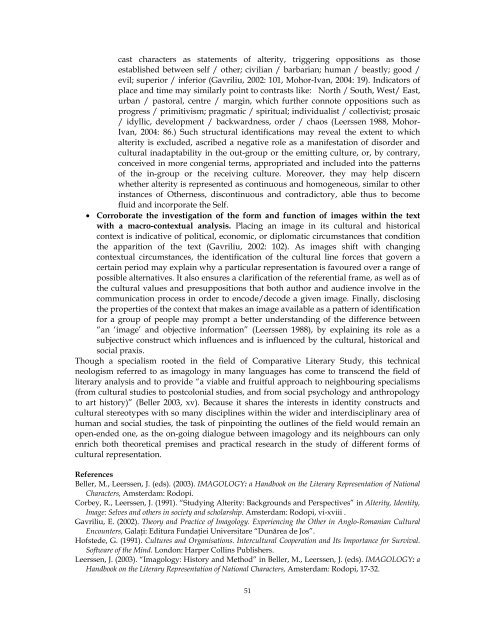Create successful ePaper yourself
Turn your PDF publications into a flip-book with our unique Google optimized e-Paper software.
cast characters as statements of alterity, triggering oppositions as those<br />
established between self / other; civilian / barbarian; human / beastly; good /<br />
evil; superior / inferior (Gavriliu, 2002: 101, Mohor-Ivan, 2004: 19). Indicators of<br />
place and time may similarly point to contrasts like: North / South, West/ East,<br />
urban / pastoral, centre / margin, which further connote oppositions such as<br />
progress / primitivism; pragmatic / spiritual; individualist / collectivist; prosaic<br />
/ idyllic, <strong>de</strong>velopment / backwardness, or<strong>de</strong>r / chaos (Leerssen 1988, Mohor-<br />
Ivan, 2004: 86.) Such structural i<strong>de</strong>ntifications may reveal the extent to which<br />
alterity is exclu<strong>de</strong>d, ascribed a negative role as a manifestation of disor<strong>de</strong>r and<br />
cultural inadaptability in the out-group or the emitting culture, or, by contrary,<br />
conceived in more congenial terms, appropriated and inclu<strong>de</strong>d into the patterns<br />
of the in-group or the receiving culture. Moreover, they may help discern<br />
whether alterity is represented as continuous and homogeneous, similar to other<br />
instances of Otherness, discontinuous and contradictory, able thus to become<br />
fluid and incorporate the Self.<br />
� Corroborate the investigation of the form and function of images within the <strong>text</strong><br />
with a macro-con<strong>text</strong>ual analysis. Placing an image in its cultural and historical<br />
con<strong>text</strong> is indicative of political, economic, or diplomatic circumstances that condition<br />
the apparition of the <strong>text</strong> (Gavriliu, 2002: 102). As images shift with changing<br />
con<strong>text</strong>ual circumstances, the i<strong>de</strong>ntification of the cultural line forces that govern a<br />
certain period may explain why a particular representation is favoured over a range of<br />
possible alternatives. It also ensures a clarification of the referential frame, as well as of<br />
the cultural values and presuppositions that both author and audience involve in the<br />
communication process in or<strong>de</strong>r to enco<strong>de</strong>/<strong>de</strong>co<strong>de</strong> a given image. Finally, disclosing<br />
the properties of the con<strong>text</strong> that makes an image available as a pattern of i<strong>de</strong>ntification<br />
for a group of people may prompt a better un<strong>de</strong>rstanding of the difference between<br />
“an ‘image’ and objective information” (Leerssen 1988), by explaining its role as a<br />
subjective construct which influences and is influenced by the cultural, historical and<br />
social praxis.<br />
Though a specialism rooted in the field of Comparative Literary Study, this technical<br />
neologism referred to as imagology in many languages has come to transcend the field of<br />
literary analysis and to provi<strong>de</strong> “a viable and fruitful approach to neighbouring specialisms<br />
(from cultural studies to postcolonial studies, and from social psychology and anthropology<br />
to art history)” (Beller 2003, xv). Because it shares the interests in i<strong>de</strong>ntity constructs and<br />
cultural stereotypes with so many disciplines within the wi<strong>de</strong>r and interdisciplinary area of<br />
human and social studies, the task of pinpointing the outlines of the field would remain an<br />
open-en<strong>de</strong>d one, as the on-going dialogue between imagology and its neighbours can only<br />
enrich both theoretical premises and practical research in the study of different forms of<br />
cultural representation.<br />
References<br />
Beller, M., Leerssen, J. (eds). (2003). IMAGOLOGY: a Handbook on the Literary Representation of National<br />
Characters, Amsterdam: Rodopi.<br />
Corbey, R., Leerssen, J. (1991). “Studying Alterity: Backgrounds and Perspectives” in Alterity, I<strong>de</strong>ntity,<br />
Image: Selves and others in society and scholarship. Amsterdam: Rodopi, vi-xviii .<br />
Gavriliu, E. (2002). Theory and Practice of Imagology. Experiencing the Other in Anglo-Romanian Cultural<br />
Encounters, Galaţi: Editura Fundaţiei Universitare “Dunărea <strong>de</strong> <strong>Jos</strong>”.<br />
Hofste<strong>de</strong>, G. (1991). Cultures and Organisations. Intercultural Cooperation and Its Importance for Survival.<br />
Software of the Mind. London: Harper Collins Publishers.<br />
Leerssen, J. (2003). “Imagology: History and Method” in Beller, M., Leerssen, J. (eds). IMAGOLOGY: a<br />
Handbook on the Literary Representation of National Characters, Amsterdam: Rodopi, 17-32.<br />
51












